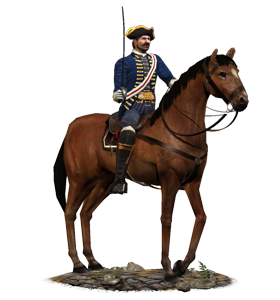Difference between revisions of "Horse Guards (ETW Unit)"
(Reverting: Wrong unit sizes) |
|||
| Line 1: | Line 1: | ||
| − | {{Unit|image=[[Image:Horse Guards.jpg]]|Class=Heavy Cavalry|Men= | + | {{Unit|image=[[Image:Horse Guards.jpg]]|Class=Heavy Cavalry|Men=60|Guns=N/A|Recruitable From=Army Staff College|Region=England, Scotland, Ireland|Recruitment Cost=1200|Upkeep Cost=300|Technology Needed=None}} |
==Overview== | ==Overview== | ||
Revision as of 07:11, 12 April 2010
Overview
It is the task of the heavy cavalry to break the enemy by shock. Simply put, the Horse Guards are expected to charge home and smash enemy ranks by weight and speed. They are not for chasing down enemies: this is the work of light cavalry forces. Instead, they are a battering ram, hurled over short distances against close-formed enemies in the hope of producing a breakthrough and further confusion. These highly trained cavalrymen lend a further touch of class, thanks to the role as part of the royal household guard, to the brutal business of a cavalry charge.
Historically, the Horse Guards remain a feature of the British Army although they now use tanks. Their name is attached to Horse Guards and Horse Guards Parade. This building complex was designed by William Kent and completed in 1755 and are still used by the Household Cavalry. Horse Guards Parade is the setting for ”Trooping of the Color”, a practice that dates back to the 17th Century. A regiment’s colors (or flags) were a rallying point in battle and so they were shown to the soldiers so they would be recognized in battle. Today, the ceremony is used to celebrate the official birthday the ruling monarch; at the time of writing Queen Elizabeth attends every year and takes the salute at the end of the parade.
